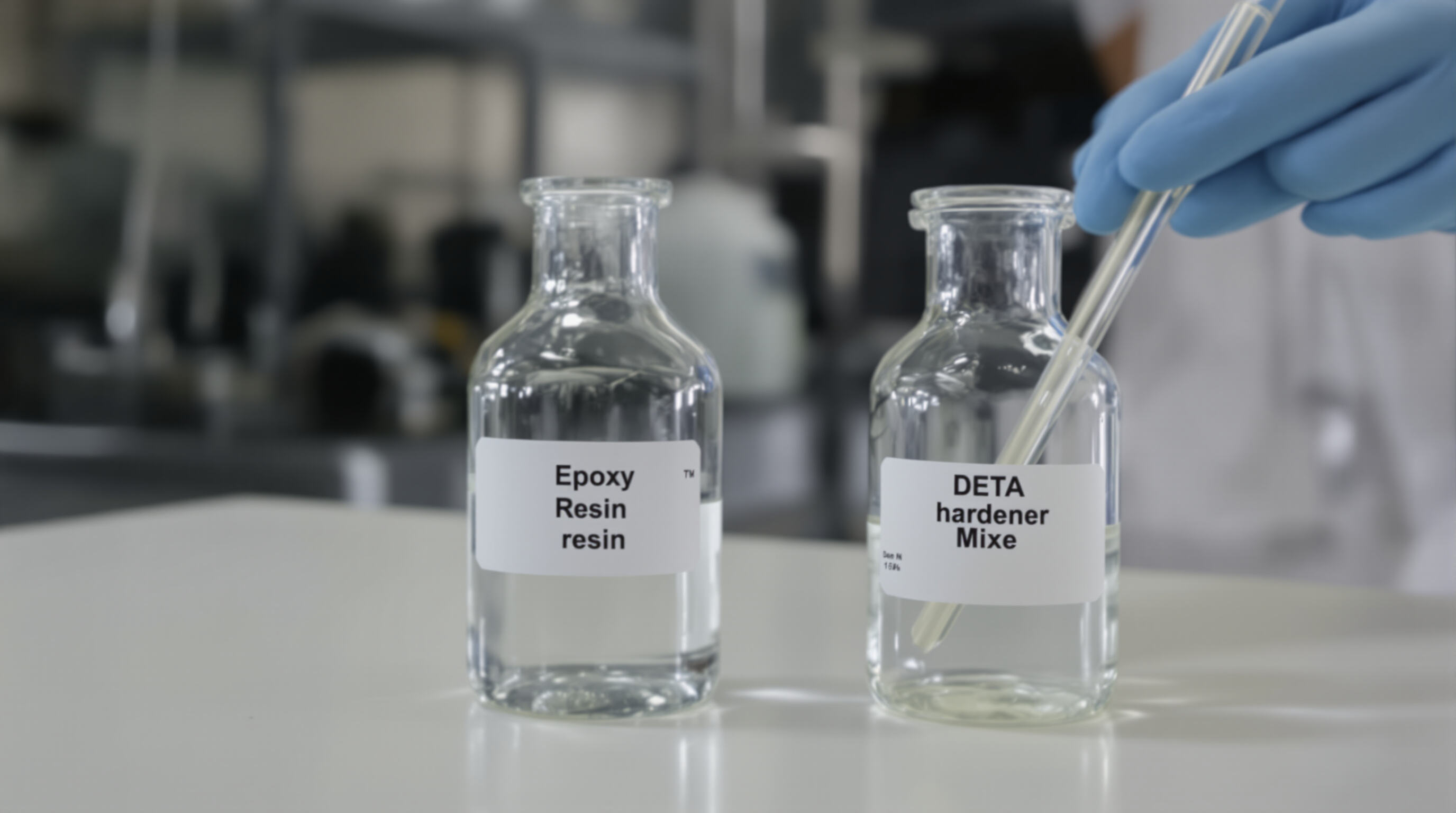Mis on DETA ja kuidas see võimaldab kiiret epoksi kõvenemist
DETA (Diethyleenitriamiin) keemiline struktuur ja omadused
DETA, mida tuntakse ka kui dietüüleentriamiini, on suhteliselt väike molekul, mille mass on umbes 103,17 grammi mooli kohta. Selle keemilise koostise hulka kuuluvad nii primaarsed kui ka sekundaarsed amiinigrupid, mis annavad sellele kuni viis punkti, kus see võib epoksühariditega ristseadmete reaktsioonide käigus seonduda. Molekuli struktuuris on tegelikult kaks ühendatud etüleenketi, mis loob midagi paindlikku pigem kui kõrb. Selle paindlikkuse tõttu on molekulide vahel vähem segamist, kui nad püüavad omavahel mõjutada. Mis see tähendab praktikas? DETA pääseb tõhusamalt pragudesse ja kooslustesse kui suuremad amiinid. See teeb sellest eriti kasulikuks olukordades, kus on vaja kiiret seondumist, näiteks kahjustatud struktuuride parandamisel pärast õnnetusi või katastroofe, kui aeg on oluline.
DETA roll kui kõrge reaktsiooniomadusega amiinikõvendajana epoksü süsteemides
DETA toimib amiinhärdena, mis käivitab epoksüüdid sisaldavate liimide kõvastusprotsessi, rünnates epoksüüdirengid, mis on leitud epoksüüdirezinis. Selle materjali vesinikekvivalent on umbes 34,4 grammi ekvivalendi kohta, mis võimaldab töötlemiseks sobivat segu suhtes umbes 100 osa rezinat ja 11 osa härdet kaalupõhiselt. See suhe aitab tagada, et keemilised reaktsioonid toimuksid õigesti ja et tekiks hea ristseose struktuur üle kogu materjali. Uuringud näitavad, et DETA saavutab toatemperatuuril (umbes 25 kraadi Celsiuse järgi) juba 45 minuti jooksul umbes 80% täielikust kõvastusastmest. See on palju kiirem kui traditsiooniliste polüamiidhärdete puhul, millel kulub sarnase tulemuse saavutamiseks tavaliselt 2–4 tundi. Kuna mehaaniline tugevus areneb nii kiiresti, siis leiavad paljud tööstuslikud töölised, et DETA on eriti kasulik ahalisest sõltuvates töödes, näiteks torustike lekete tihendamisel või kiirete remonditööde ajal olevate kiirte stabiliseerimisel, kus kiirus on kõige olulisem.
Kuidas DETA kiirendab võrreldes standardsete kõvastajatega ristseostumist
DETA epoksüüdri kõvastamise kiirus tuleneb kolmest olulisest tegurist:
- Madalam aktiveerimisenergia (42 kJ/mol vs 58 kJ/mol TETA puhul), mis võimaldab kiiremat reaktsiooni alustamist
- Suurem amiinide mobiilsus selle kompaktse, lineaarse molekulstruktuuri tõttu
- Vähene ahelate segunemine varajases polümerisatsiooni etapis
Kiire ristseostumise protsess annab tõesti lühikesed želeerumisaeg, umbes 4 minutit, kui temperatuur on umbes 30 kraadi, kuid sellel on ka hind. Impaktkindlus langeb ligikaudu 18% võrreldes aeglasemate kõvastamismeetoditega. Seetõttu on paljud inimesed, kes nendega materjalidega töötavad, kalduvad lisama kera silikatäitjaid või teisi aditiive, eriti kui on tegemist remontidega, mis toimuvad suure koormuse all. Loomulikult on see mõistlik kiirete olukordade puhul, kus on oluline asjad kiiresti parandada, isegi kui tugevusomadused on nappimad.
Kiire kõvastumisega epoksüüdi teadus DETA abil: mehhanismid ja kompromissid

Kõvastamise kinetika: kuidas DETA kiirendab polümerisatsiooni
DETA kiirendab epoksüüdite kõvastamist, kuna tal on palju amiinrühmi ja struktuurilt ei sega ta iseendale reaktsiooni, seega reageerib ta epoksiidmolekulidega kiiresti. Kui võrrelda DETA-d TETA-ga, siis on nende toimivuses selge erinevik. DETA molekulide ehitus võimaldab neil liikuda vabamalt smoli maatriksis ja kiiremini jõuda kõikidesse sidemekohtadesse. Testid näitavad, et see võib vähendada želeerumisaega ligikaudu 40 protsenti, samas kui lõpliku ristseotud võrgustiku kvaliteet jääb säilima. Ettevõtetele, kes töötavad projektidega, kus osi on vaja kasutada võimalikult kiiresti, on see kiiruse kasv oluline mõju nende töövoogude kavandamisele ja tootmisplaanidele.
Kõvastamise kiiruse ja mehaanilise toimivuse tasakaalustamine
Kui materjalid kõvenevad kiiresti, siis peaaegu alati on sellega seotud mõni kompromiss nende tugevusega. Võtke näiteks DETA põhised epoksüidid, mis jõuavad tavaliselt oma täistugevusest umbes 80%-ni juba kahe tunni jooksul. Aga siin on küsimus: nende tõmbetugevus on sageli 10 kuni isegi 15% väiksem võrreldes nendega, mis kõvenevad erinevate kõvendajatega aeglasemalt. Siiski on mõnel juhul kiirus olulisem kui ideaalne tugevus. Mõelge näiteks lennukiosade remondile lennu keskel või teede remondile äikesepajal. Struktuurilt tugeva lahenduse saamine kohe on sellistes olukordades olulisem kui ootamine maksimaalse vastupidavuse nimel. Head uudis on, et tootjad on töötanud välja koostiseid, mis suudavad selle tugevuslõhe lepitäieks hoida, säilitades samas kiire kõvenemisaega. Mõned ettevõtted segavad tegelikult traditsioonilisi aeglasemalt kõvenevaid komponente väikestes kogustes, et saavutada mõlema maailma parimad aspektid.
Põõravormi mõju DETA-juhitavatele kõvenemise kiiretele
Põhiresin ja lisandid mõjutavad DETA reaktiivsust oluliselt:
- Bisfenool-A-põhised resinid kõvenevad DETA-ga 50% kiiremini kui novolakttüüpi resinid epoksiidi kättesaadavuse tõttu
- Plastifikaatorid pikendavad tööaega 15–20 minutit, ilma et kõvenemise algust oluliselt viivitataks
- Alla 15 °C temperatuuril langeb DETA reaktiivsus järsult; 5–8% bensoilalkoholi lisamine taastab toimivuse, vähendades reaktsiooni energiabarjääri
Muutes resinkeemia, saavad tootjad optimeerida DETA-põhiseid süsteeme väljakasutuseks, kus usaldusväärsus ja kiire kõvenemine on olulised.
Tegurid, mis mõjutavad DETA-põhiste epoksiidide kõvenemise kiirust
Temperatuuri optimeerimine kiireks kõvenemiseks välistingimustes
Kui jõutakse DETA-põhiste epoksüüde kõvenemiseni, siis temperatuur on kõige olulisem. Ideaalne temperatuurivahemik nende reaktsioonide jaoks jääb kuskile 20 kuni 25 kraadi Celsiuse vahemikku ja huvitaval kombel kiireneb kõvenemisprotsess umbes kaks korda, kui temperatuur tõuseb ligikaudu 10 kraadi võrra (näidatud 2022. aasta epoksüüde kõvenusainete uuringus). Külma ilm tekitab töötajatele probleeme, kes püüavad sageli enne tööd pindu soojendada või kasutada käegakättesolevaid infrapunakütteid, et tagada töö käigus hoida kõik korras. Teisalt nõuab äärmeline kuumus ka erinevaid taktikaid – paljud meeskonnad seavad nüüd oma seguvalmistusala varju, et vältida materjali geleks muutumist enne, kui seda üldse rakendada jõutakse. Tänapäeval on enamik välioperatsioone hakanud tavapäraselt temperatuuri kontrollimist oma tööprotsessi integreerima lihtsalt seetõttu, et keegi ei taha epoksüütöödest ebaühtlasi tulemusi.
DETA reaktiivsuse parandamiseks kasutatavad keemilised kiirendusained
Kui segusse lisatakse keemilisi kiirendajaid, nagu tertsiaarsed amiinid või teatud fenoolilised ühendid, väheneb DETA aktiveerimisenergia umbes 30–40 protsenti, nagu on näidatud 2022. aasta Materjalide reaktiivsuse uuringus. Praktiliselt tähendab see, et ristseotumine toimub palju kiiremini, mõnel juhul isegi kahekordistab kiirust mõnes rakenduses. Nende lisandite toimimise mehhanism on tegelikult üsna huvitav – nad aitavad stabiliseerida seda, mida keemikud nimetavad reaktsiooni amiiin-epoksiide üleminekufaasiks, mis muudab kõik sujuvaks ja tõhusamaks. Kuid siin on üks puudus, millest tasub mainida. Kui keegi liigub üle soovitatud kontsentratsiooni, mis on umbes 2%, hakkavad materjalid muutuma liiga habraks. Seetõttu rõhutavad kogemustega tehnikud alati täpse mõõtmise olulisust nende materjalidega töötamisel. Reaktsiooni kiiruse ja materjali tugevuse vahelise tasakaalu leidmine on kriitiline igaühele, kes soovib optimeerida oma kõvenemisprotsessi, jättes samas säilitada struktuuritervisust.
Potensi elamise ja töötlemise haldamine ajalise surve all
DETA kiire reaktsioonikiirus tähendab, et materjal jääb töötlemiseks vaid umbes 8 kuni 12 minutiks, kui temperatuur jõuab umbes 25 kraadini Celsiuse järgi, mis tekitab tõelisi probleeme kõigile, kes üritavad seda käsitsi segada. Valdkonnas on ilmunud uued arendused, mis on tutvustanud midagi, mida nimetatakse reaktiivseteks lahjendajateks, mis venitavad tööaega umbes 20 protsenti, säilitades siiski piisavalt kiire kõvenemise enamikuks rakendusteks, nagu on kirjeldatud 2023. aasta Polymer Engineering Reports'i väljaandes. Praktiliselt toetuvad enamik professionaale nüüd tugevalt nendele eelnevalt mõõdetud kahepatjadega paigaldustele ning mitmesugustele automaatse dosimeetriga seadmetele, et tagada vajalik 1:1 suhe igakordsel materjali kasutamisel nendes ajaliste piirangutes.
DETA hädaolukordlike remondirakenduste puhul: reaalse maailma jõudlus

Kiire kõvenemisega epoksüüdide nõudlus kriitilise infrastruktuuri remondi puhul
Kui jõuallamite, sildade ja torustike võrgustike kõigi oluliste struktuuride hooldamisel on tegemist hädaolukorraga, siis eelistavad hooldusmeeskonnad asju kiiresti parandada raha säästmise asemel. Uuringust, mille tegi 2023. aastal Infrastruktuurikindluse instituut, selgus, et iga neljast ümber kolm inimest valisid kiiresti kõvenevaid epoksikütte, kui oli vaja midagi kiiresti parandada. DETA süsteemid on tegelikult üsna imeline asi. Need võivad kõveneda vaid 15 kuni 25 minuti jooksul, samas kui tavapärane epoksi kõveneb väga kaua – mõnikord kuni neli tundi. Ja need kiiremad valikud suudavad kohe alustada ka üsna hästi, andes algse tugevuse näitajaks üle 18 MPa, mis on üsna muljetavaldav, arvestades, kui kiirelt nad töötavad.
Juhtumiuuring: Struktuuride kleepimine DETA epoksiga hädaolukordades
Kui kõrge rõhu tingimustes toimus torujuhtme katkemine, kasutasid väljatöötajad aktiivsete pragude remondiks spetsiaalset DETA-põhise epoksüüde segu, jäädes veerõhuks umbes 40 PSI. Vaid 90 minuti jooksul pärast rakendamist jõudis see materjal oma maksimaalse survekindlusega 52 MPa, seega võisid teenused jätkata normaalset tööd isegi tippuhetel. Väljaingenjöörid märkisid, et remont aegus umbes 40 protsenti vähem aega kui varem kasutatud amiiniga kõvastatud süsteemidega. Selline toime on eriti oluline hädaolukordades, kus iga minut loeb.
Olulisemad näitajad: kõvenemisaeg, adhesioonijõud ja vastupidavus
| Omadus | DETA-põhiline epoksiid | Standardne epoksiid | Paranduste |
|---|---|---|---|
| Esialgne kõvenemisaeg | 18 min | 240 min | 92% kiirem |
| 24 tunni järele nihkejõud | 24,3 MPa | 19,1 MPa | 27% kasv |
| Tsükliline koormuskindlus | 12 500 tsüklit | 8200 tsüklit | 52% pikem |
Kiirene vananemiskatsed (ASTM D1183-03) kinnitavad, et DETA-ga kõvenenud liidud säilitavad korrosiooni keskkonnas ühe aasta pärast 94% oma algsest tugevusest, mis aitab lahendada kiiret kõvenemist vajavate remondisüsteemide pikaajalise vastupidavuse probleeme.
KKK
Milleks kasutatakse DETA epoksüüdisüsteemides?
DETA toimib kõrge reaktiivsusega amiinide kõvenajana, mis käivitab epoksüüdisüsteemides kõvenemisprotsessi, tagades kiire ristseose ja kiire liimimise.
Kui kiiresti kõveneb DETA epoksüüdharju?
DETA saavutab toatemperatuuril umbes 80% täielikust kõvastumisest juba 45 minuti jooksul, mis on oluliselt kiirem kui traditsioonilised kõvastajad.
Mis on DETA kasutamise eelised ja kompromissid epoksüüdi kõvastamisel?
DETA pakub kiiret kõvastumist, mis on kasulik ajaomased projektide jaoks. Siiski võib see võrreldes aeglasemalt kõvastavate alternatiividega mõjutada teatud mehaanilist tugevust.
Kuidas saab DETA-põhiste epoksüüdide kõvastamise kiirust optimeerida?
Kõvastamise kiirust saab optimeerida temperatuuri reguleerimise, keemiliste kiirendajate lisamise ning potensiiaali kontrollimise kaudu reaktiivsete lahustite ja muude meetodite abil.

